Slug
multiple-sclerosis
Video
Category
NeuroImmunology
Excerpt
Multiple Sclerosis (MS) is the most common disabling neurological disease of young adults. It most often appears when people are between 20 to 40 years old. However, it can also affect children and older people.
Authors
Tags
Featured
Featured
Ready to Publish
Ready to Publish
Publish Date
Oct 13, 2022
Contents
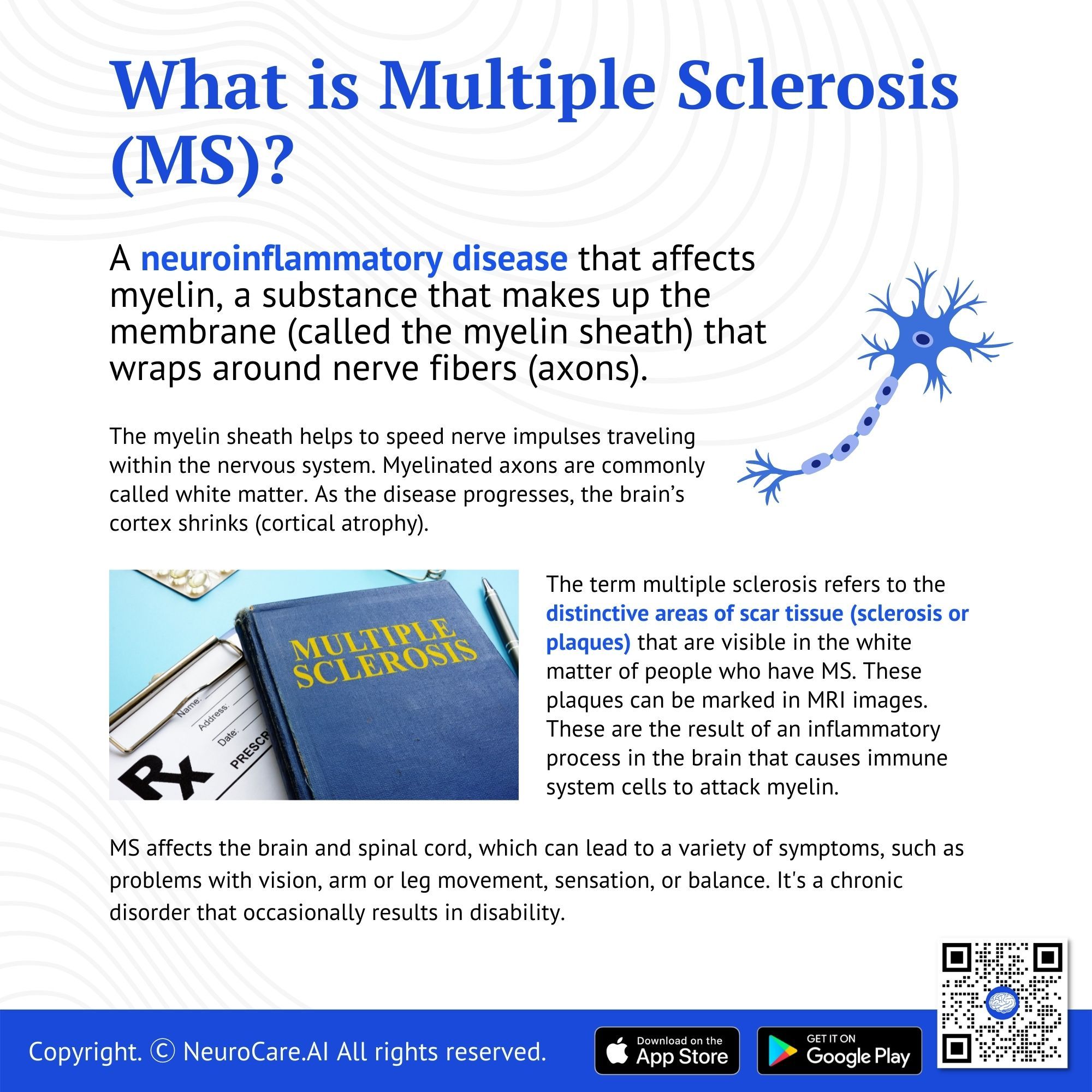
What is multiple sclerosis (MS)?
Multiple sclerosis (MS) is a neuroinflammatory disease that affects myelin , a substance that makes up the membrane (called the myelin sheath) that wraps around nerve fibers (axons). The myelin sheath helps to speed nerve impulses traveling within the nervous system. Myelinated axons are commonly called white matter. As the disease progresses, the brain’s cortex shrinks (cortical atrophy).
MS affects the brain and spinal cord, which can lead to a variety of symptoms, such as problems with vision, arm or leg movement, sensation, or balance. It's a chronic disorder that occasionally results in disability.
The term multiple sclerosis refers to the distinctive areas of scar tissue (sclerosis or plaques) that are visible in the white matter of people who have MS. These plaques can be marked in MRI images. Plaques are the result of an inflammatory process in the brain that causes immune system cells to attack myelin.
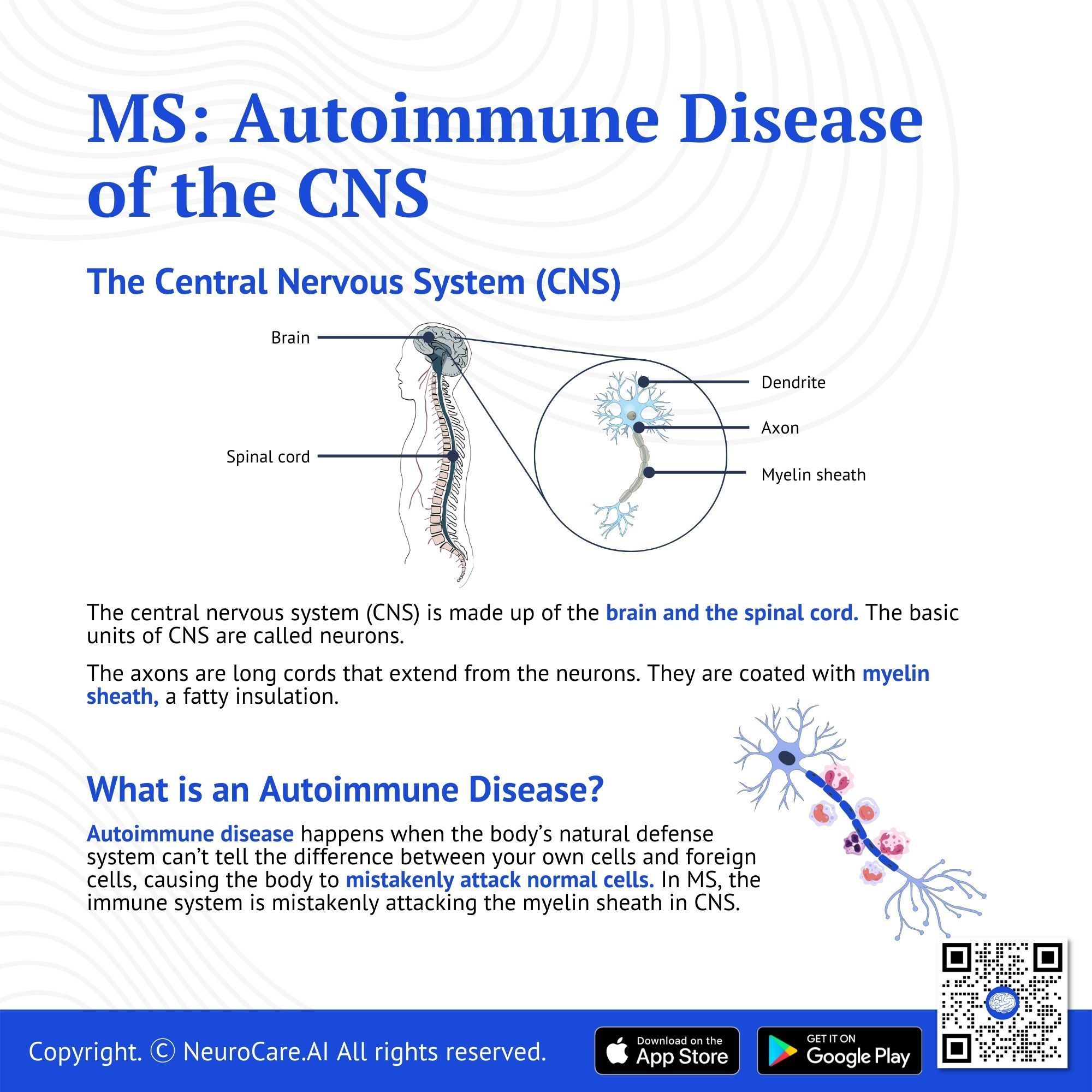
MS: Autoimmune Disease of CNS
The central nervous system (CNS) is made up of the brain and the spinal cord. The basic units of CNS are called neurons. The neurons are the basic building blocks of the CNS and it is these cells that send and receive messages to and from other cells or organs in order to control our body functions.
The tissue of the CNS is made up of grey matter and white matter. Grey matter is made up of neurons, cells and blood vessels. White matter is made up of axons, which are long cords that extend from the neurons. They are coated with myelin sheath, a fatty insulation.
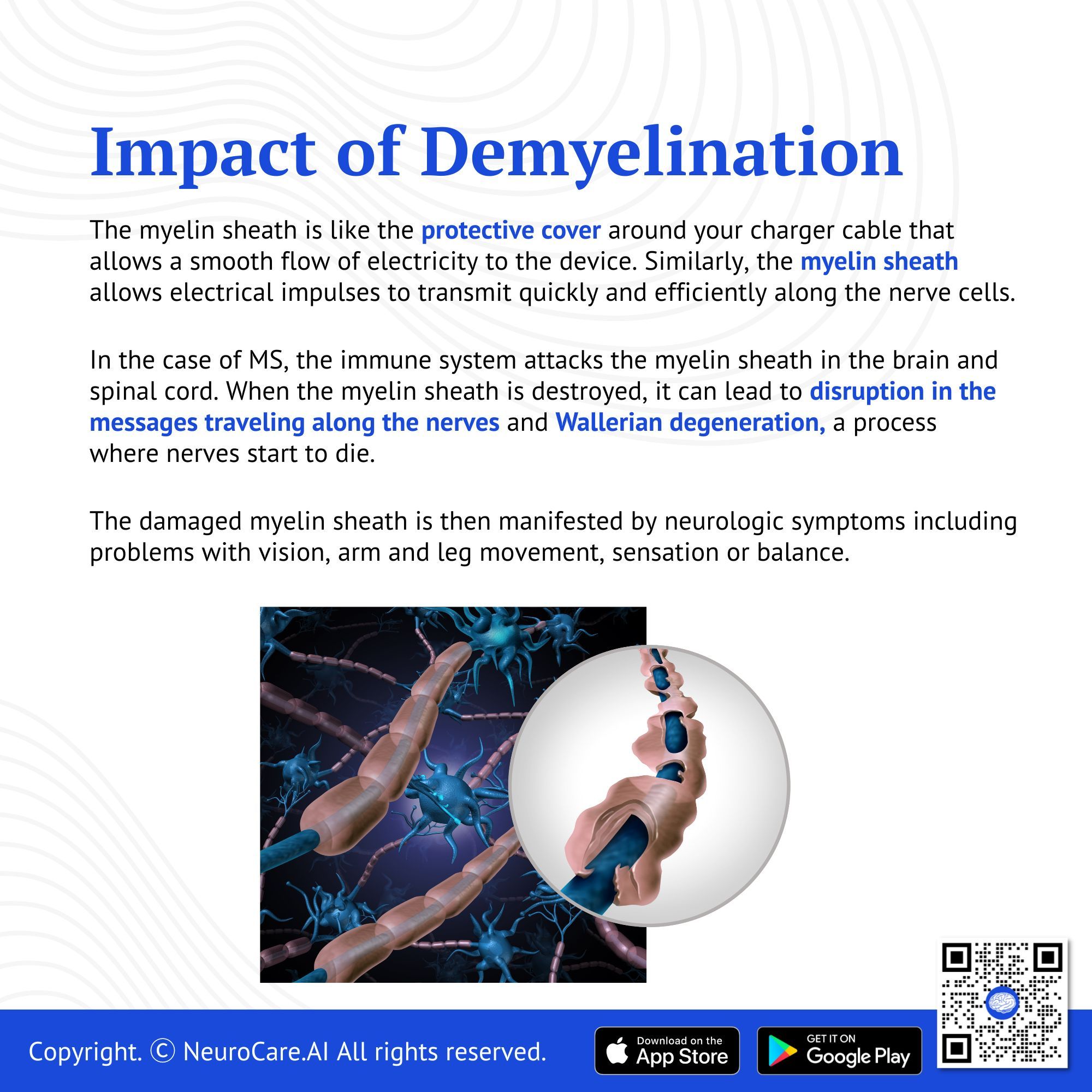
Impact of Demyelination
The myelin sheath is like the protective cover of your charger cable that allows a smooth flow of electricity to the device. Similarly, the myelin sheath allows electrical impulses to transmit quickly and efficiently along the nerve cells.
In the case of MS, the immune system attacks the myelin sheath in the brain and spinal cord. When the myelin sheath is destroyed, it can lead to disruption in the messages traveling along the nerves and Wallerian degeneration, a process where nerves start to die.
The damaged myelin sheath is then manifested by neurologic symptoms including problems with vision, arm and leg movement, sensation or balance.
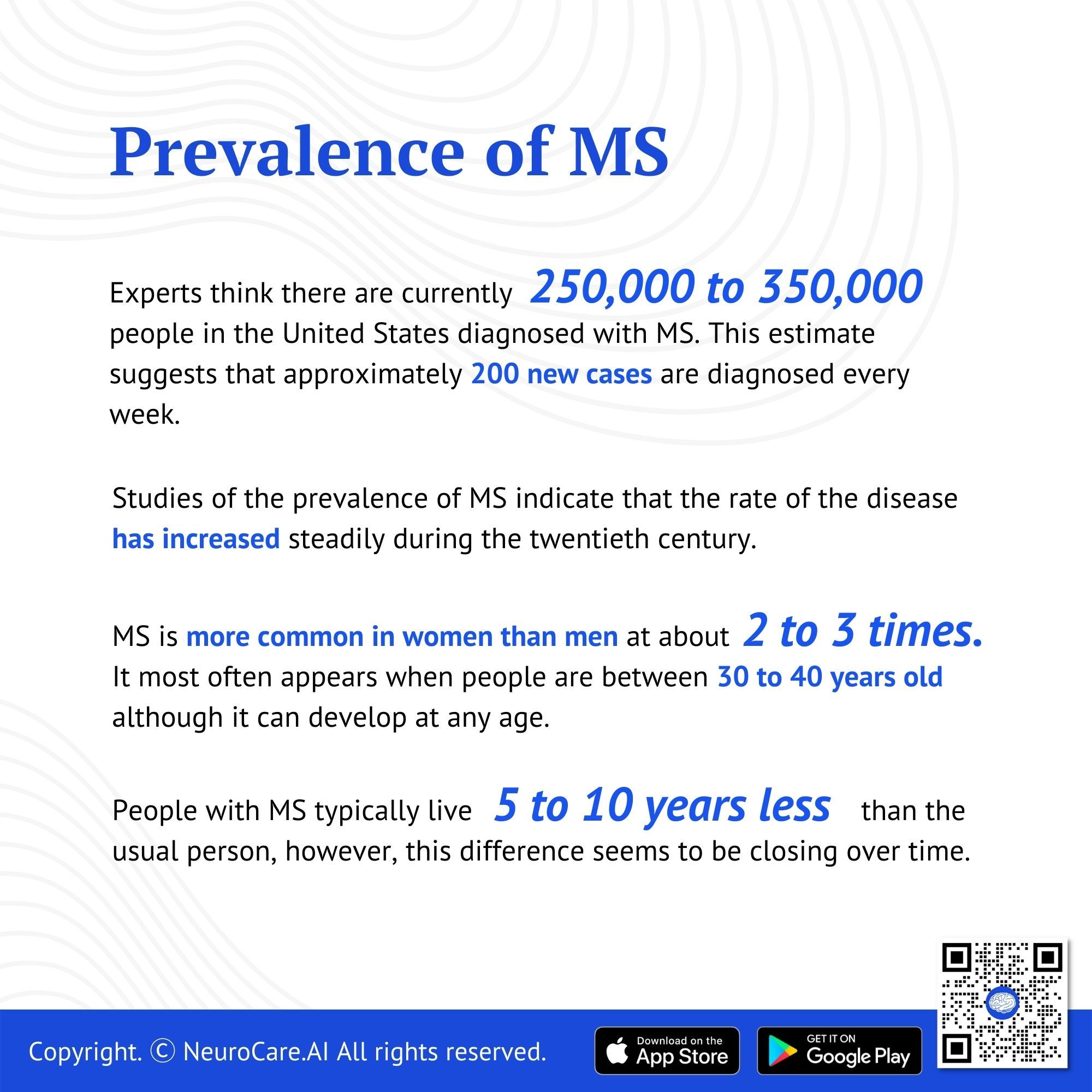
Prevalence of MS
Experts think there are currently 250,000 to 350,000 people in the United States diagnosed with MS. This estimate suggests that approximately 200 new cases are diagnosed every week. Studies of the prevalence (the proportion of individuals in a population having a particular disease) of MS indicate that the rate of the disease has increased steadily during the twentieth century. MS is more common in women than men at about 2 to 3 times. It most often appears when people are between 30 to 40 years old although it can develop at any age. People with MS typically live 5 to 10 years less than the usual person, however, this difference seems to be closing over time.
Signs and symptoms of MS
The symptoms of MS usually begin over one to several days, but in some forms, they may develop more slowly. They may be mild or severe and may go away quickly or last for months. Because symptoms come and go in the majority of people with MS, the presence of symptoms is called an attack, or in medical terms, an exacerbation. Recovery from symptoms is referred to as remission, while a return of symptoms is called a relapse.
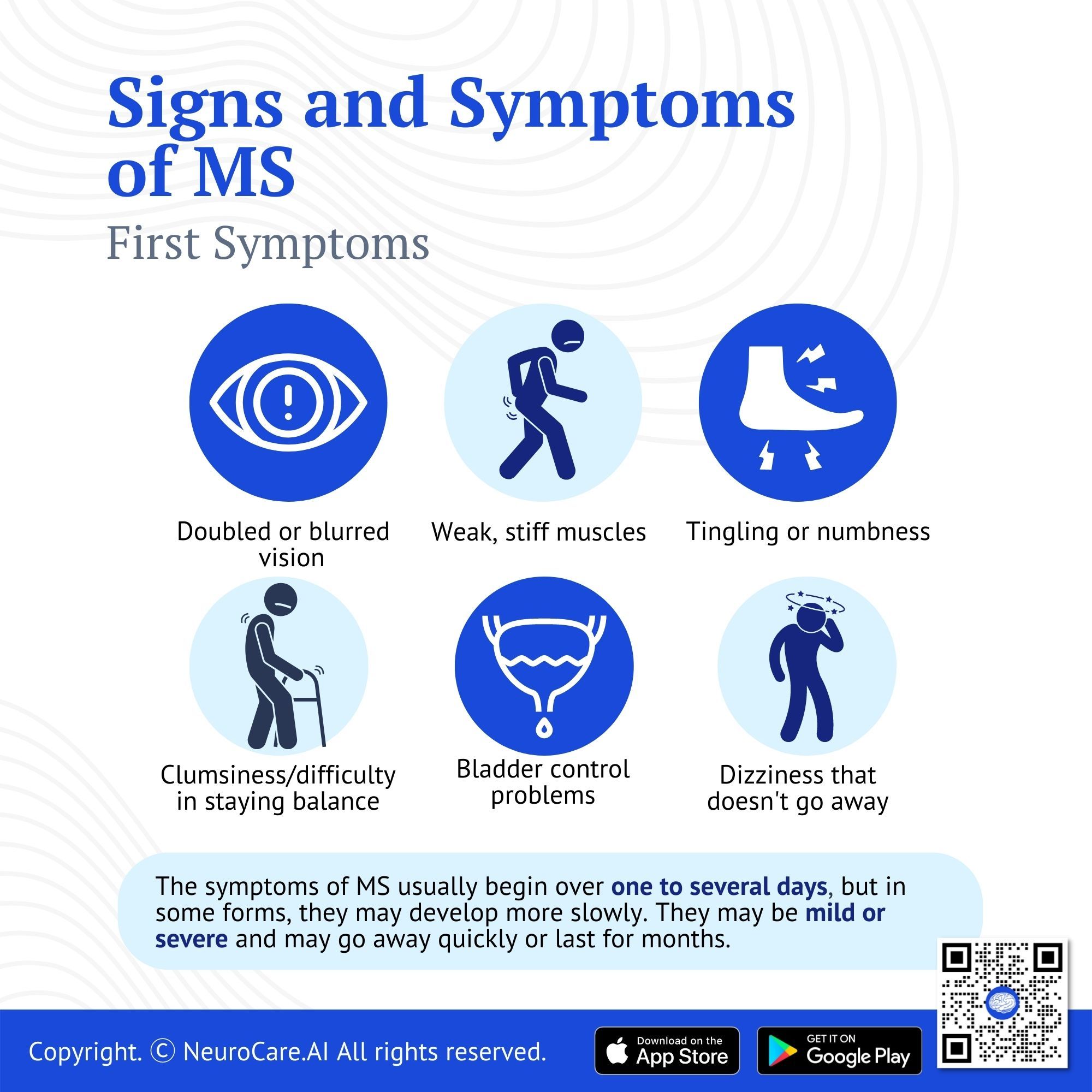
First symptoms
The first symptoms of MS often include:
- Vision problems such as blurred or double vision or optic neuritis, which causes pain in the eye and a rapid loss of vision,
- Weak, stiff muscles, often with painful muscle spasms,
- Tingling or numbness in the arms, legs, trunk of the body, or face,
- Clumsiness, particularly difficulty staying balanced when walking,
- Bladder control problems, either inability to control the bladder or urgency, and
- Dizziness that doesn't go away.
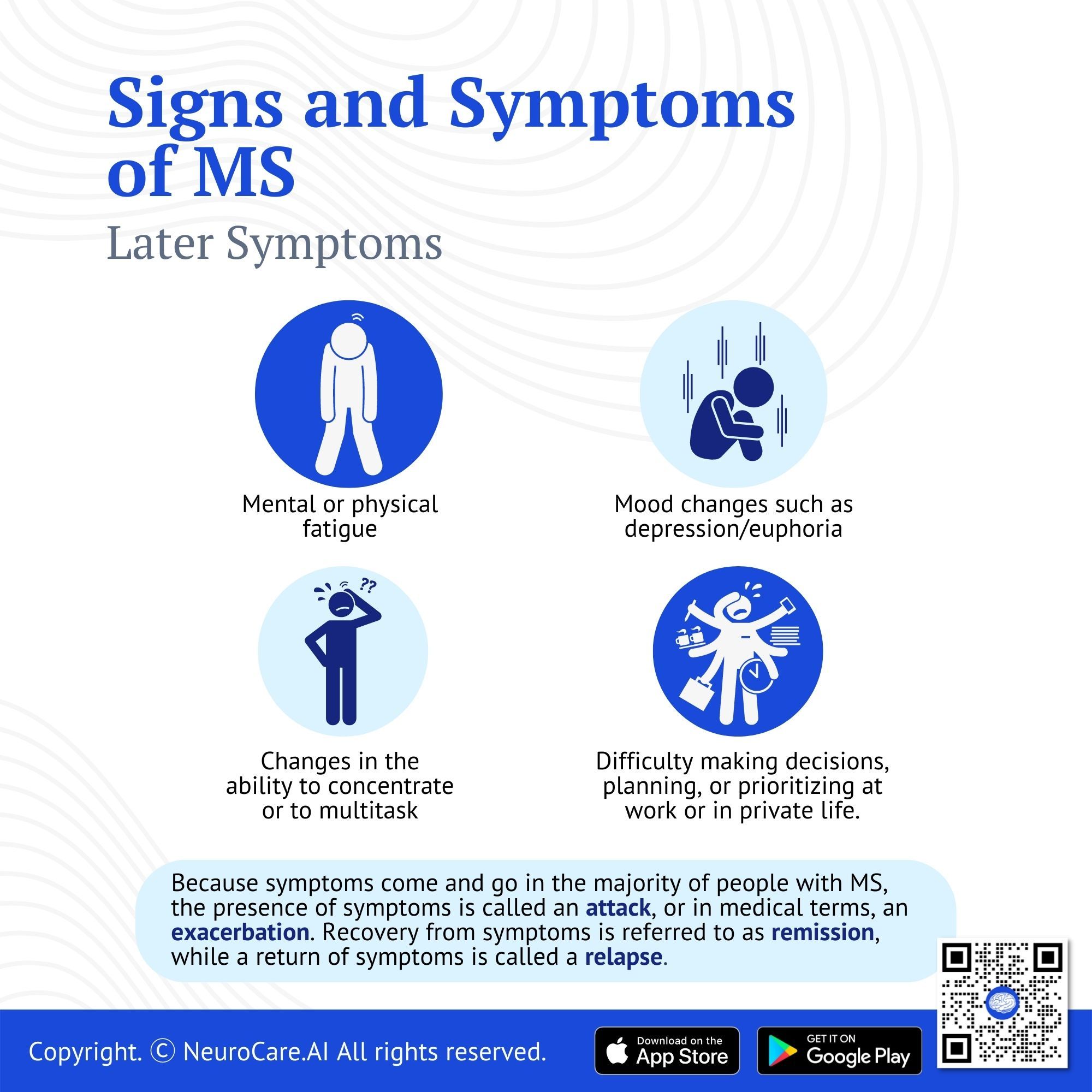
Later symptoms
MS may also cause later symptoms such as:
- Mental or physical fatigue which accompanies the above symptoms during an attack,
- Mood changes such as depression or euphoria,
- Changes in the ability to concentrate or to multitask effectively, and
- Difficulty making decisions, planning, or prioritizing at work or in private life.
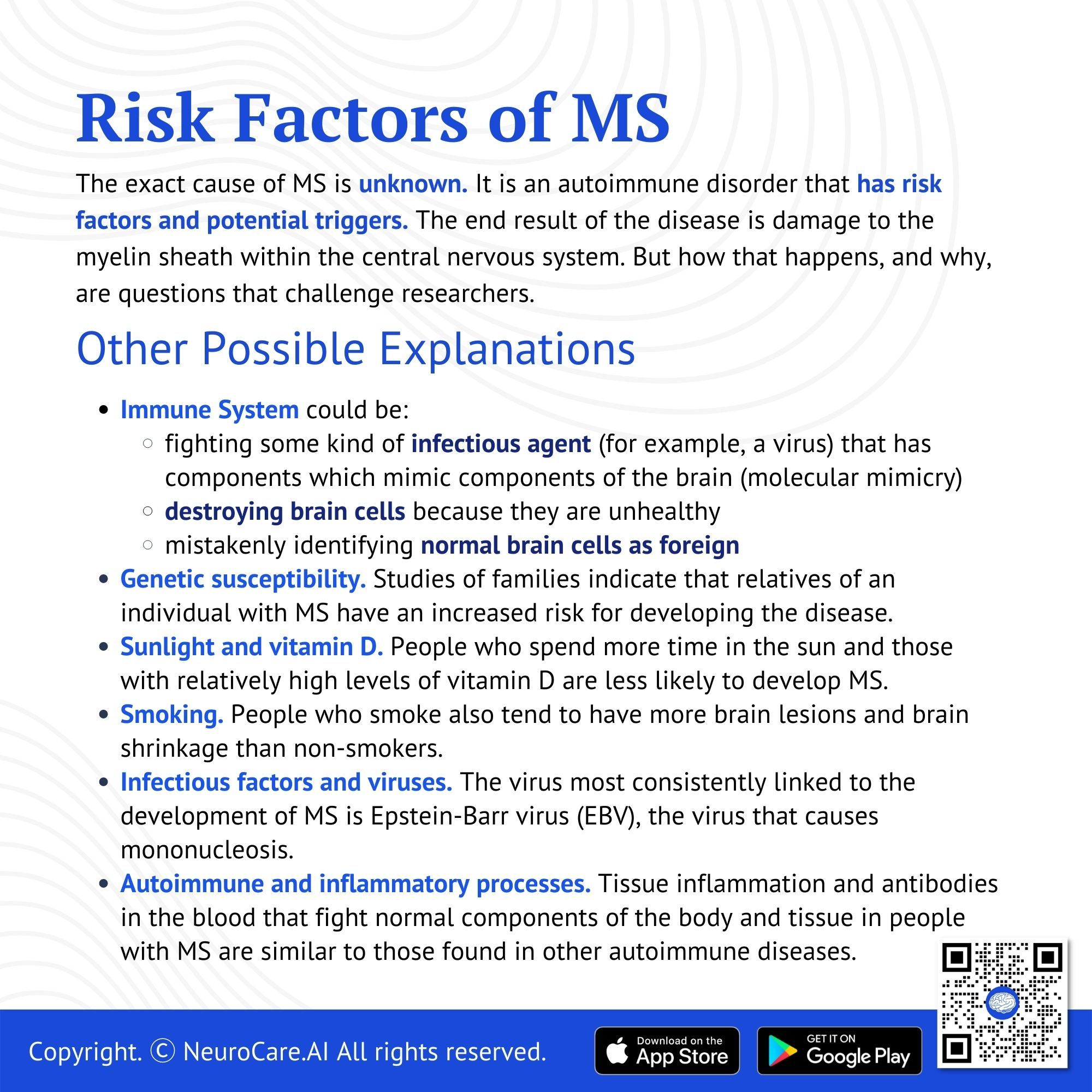
Risk Factors of MS
The exact cause of MS is unknown. It is an autoimmune disorder that has risk factors and potential triggers. The end result of the disease is damage to the myelin sheath within the central nervous system. But how that happens, and why, are questions that challenge researchers.
Researchers have several possible explanations for what might be going on. The immune system could be:
- fighting some kind of infectious agent (for example, a virus) that has components that mimic components of the brain (molecular mimicry)
- destroying brain cells because they are unhealthy
- mistakenly identifying normal brain cells as foreign
Genetic susceptibility. Susceptibility to MS may be inherited. Studies of families indicate that relatives of an individual with MS have an increased risk for developing the disease.
Sunlight and vitamin D. A number of studies have suggested that people who spend more time in the sun and those with relatively high levels of vitamin D are less likely to develop MS. Researchers believe that vitamin D may help regulate the immune system in ways that reduce the risk of MS.
Smoking. A number of studies have found that people who smoke are more likely to develop MS. People who smoke also tend to have more brain lesions and brain shrinkage than non-smokers.
Infectious factors and viruses. A number of viruses have been found in people with MS, but the virus most consistently linked to the development of MS is Epstein Barr virus (EBV), the virus that causes mononucleosis.
Autoimmune and inflammatory processes. Tissue inflammation and antibodies in the blood that fight normal components of the body and tissue in people with MS are similar to those found in other autoimmune diseases. Along with overlapping evidence from genetic studies, these findings suggest that MS results from some kind of disturbed regulation of the immune system.
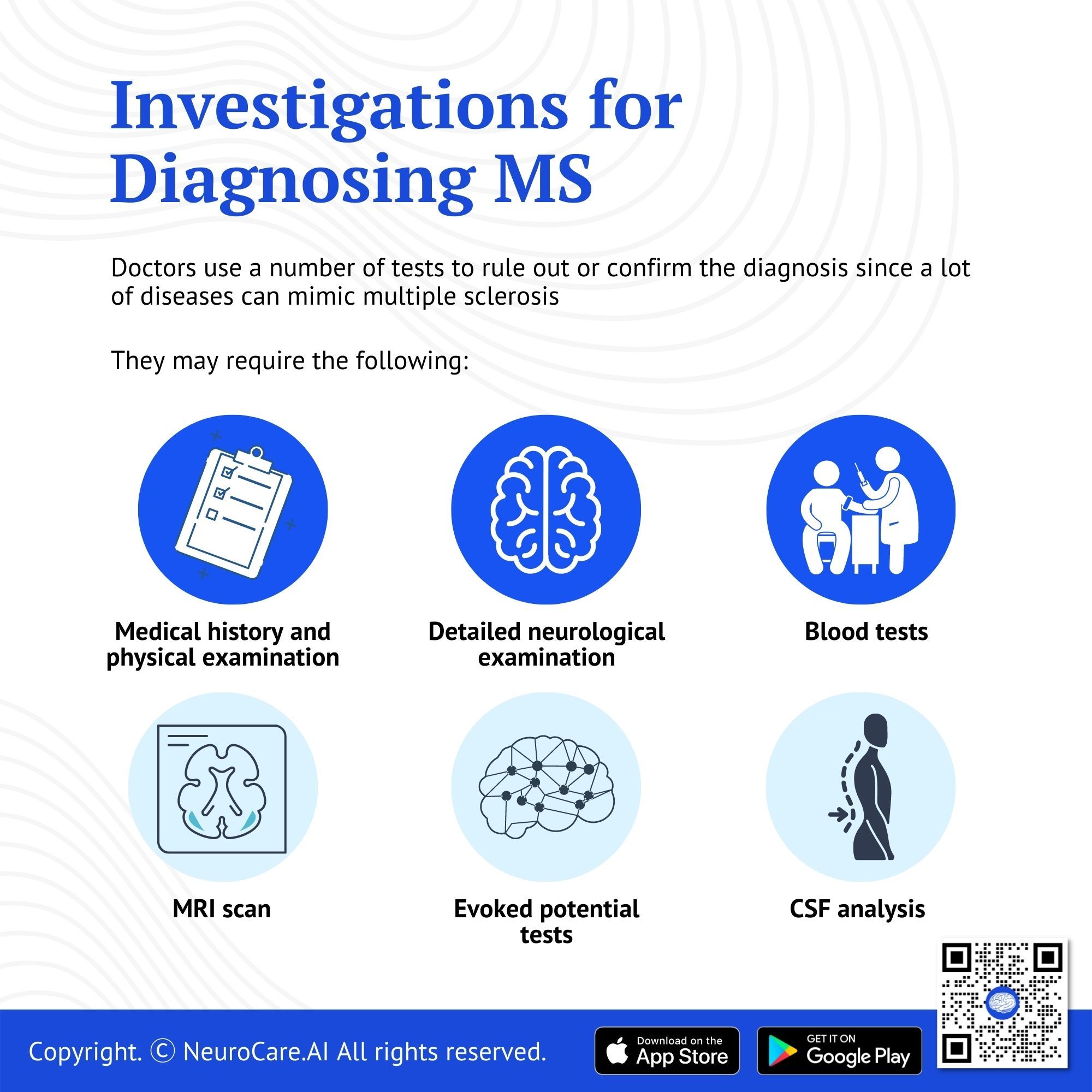
Investigations for diagnosing MS
There is no single test used to diagnose MS. Doctors use a number of tests to rule out or confirm the diagnosis. There are many other disorders that can mimic MS. Therefore it is very important to perform a thorough investigation before making a diagnosis.
MRI. In addition, to complete medical history, physical examination, and a detailed neurological examination, a doctor will order an MRI scan of the brain and spine to look for the characteristic lesions of MS. Then a special dye or contrast agent is injected into a vein and the MRI is repeated. In regions with active inflammation in MS, there is disruption of the blood-brain barrier and the dye will leak into the active MS lesion.
Evoked Potential Tests. Doctors may also order these tests which use electrodes on the skin and painless electric signals to measure how quickly and accurately the nervous system responds to stimulation.
CSF Analysis. In addition, doctors may request a lumbar puncture (sometimes called a "spinal tap") to obtain a sample of cerebrospinal fluid (CSF). This allows them to look for proteins and inflammatory cells associated with the disease and to rule out other diseases that may look similar to MS, including some infections and other illnesses.
Blood Tests. Usually, blood tests are done to rule out any other potential reasons for symptoms.
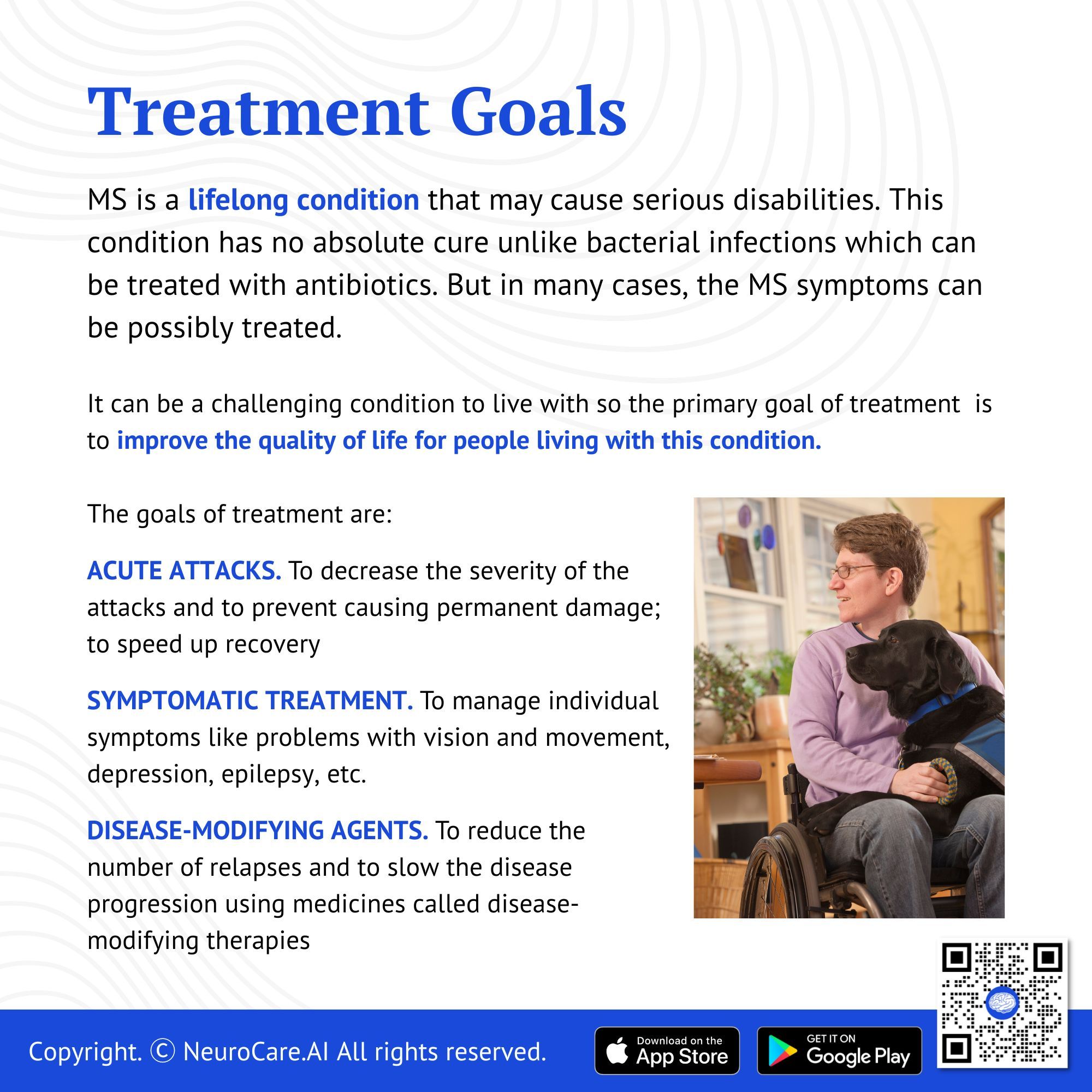
Treatment Goals
MS is a lifelong condition that may cause serious disabilities. This condition has no absolute cure unlike bacterial infections which can be cured with antibiotics. But in many cases, the MS symptoms can be possibly treated.
It can be a challenging condition to live with so the primary goal of treatment is to improve the quality of life for people living with this condition.
The goals of treatment are:
- Acute attacks. To decrease the severity of the attacks and to prevent causing permanent damage; to speed up recovery of the acute phase illness
- Symptomatic treatment. To manage individual symptoms like problems with vision and movement, depression, epilepsy, etc.
- Disease-modifying agents. To reduce the number of relapses and to slow the disease progression using medicines called disease-modifying therapies
Treatment for MS
There is still no cure for MS, but there are treatments for acute attacks, medications, therapies to improve symptoms, and recently developed drugs to slow the worsening of the disease.
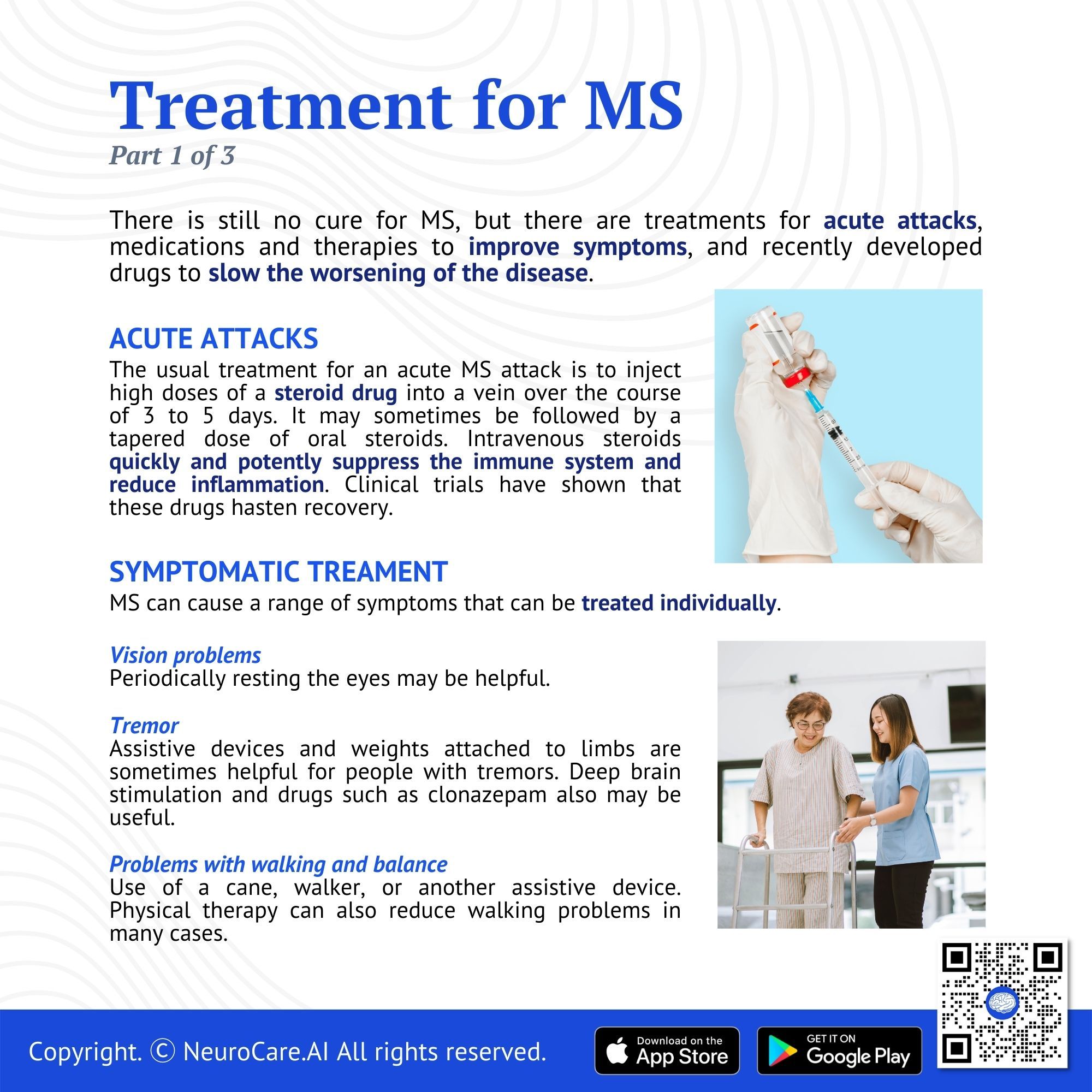
Acute attacks
The usual treatment for an acute MS attack is to inject high doses of a steroid drug, such as methylprednisolone, intravenously (into a vein) over the course of 3 to 5 days. It may sometimes be followed by a tapered dose of oral steroids. Intravenous steroids quickly and potently suppress the immune system and reduce inflammation. Clinical trials have shown that these drugs hasten recovery.
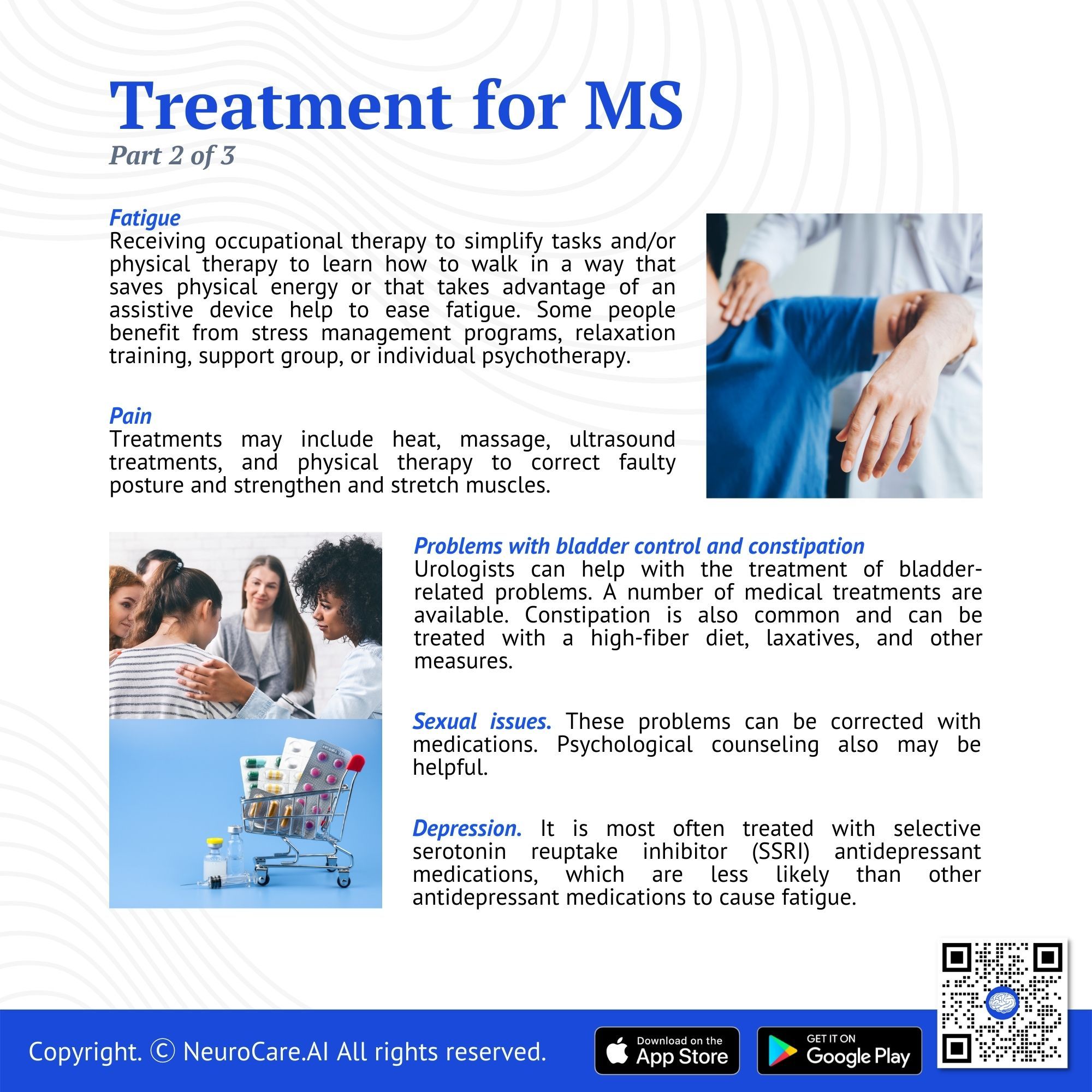
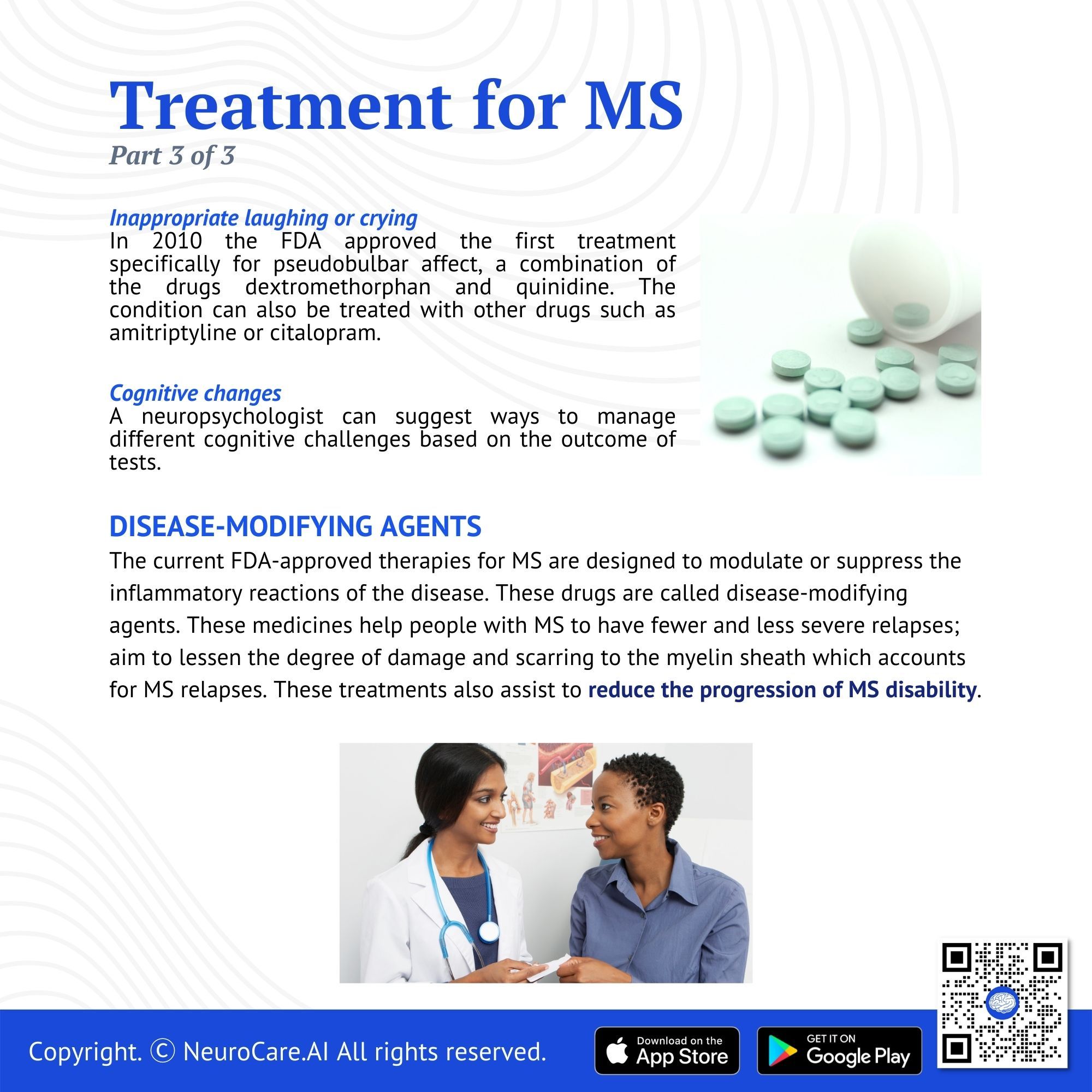
Symptomatic treatment
MS can cause a range of symptoms that can be treated individually.
Vision problems. Eye and vision problems are common in people with MS but rarely result in permanent blindness. Periodically resting the eyes may be helpful.
Tremor. People with MS sometimes develop tremors, or uncontrollable shaking, often triggered by movement. Assistive devices and weights attached to limbs are sometimes helpful for people with tremors. Deep brain stimulation and drugs such as clonazepam also may be useful.
Problems with walking and balance. Many people with MS experience difficulty walking. The use of a cane, walker, or another assistive device is beneficial. Physical therapy can also reduce walking problems in many cases.
Fatigue. Fatigue may be reduced if the person receives occupational therapy to simplify tasks and/or physical therapy to learn how to walk in a way that saves physical energy or takes advantage of an assistive device. Some people benefit from stress management programs, relaxation training, membership in an MS support group, or individual psychotherapy.
Pain. People with MS may experience several types of pain during the course of the disease. Treatments may include heat, massage, ultrasound treatments, and physical therapy to correct faulty posture and strengthen and stretch muscles; prescription of anticonvulsant or antispasmodic drugs, and other drugs that help to reduce central pain.
Problems with bladder control and constipation. The most common bladder control problems encountered by people with MS are urinary frequency, urgency, or loss of bladder control. Urologists can help with the treatment of bladder-related problems. A number of medical treatments are available. Constipation is also common and can be treated with a high-fiber diet, laxatives, and other measures.
Sexual issues. People with MS sometimes experience sexual problems and these can be corrected with medications. Psychological counseling also may be helpful.
Depression. Studies indicate that clinical depression is more frequent among people with MS than it is in the general population or in persons with many other chronic, disabling conditions. It is most often treated with selective serotonin reuptake inhibitor (SSRI) antidepressant medications, which are less likely than other antidepressant medications to cause fatigue.
Cognitive changes. A number of neuropsychological tests have been developed to evaluate the cognitive status of individuals with MS. Based on the outcomes of these tests, a neuropsychologist can suggest ways to manage different cognitive challenges.
Disease-modifying agents
During the past 20 years, researchers have made major breakthroughs in MS treatment due to new knowledge about the immune system. The current FDA-approved therapies for MS are designed to modulate or suppress the inflammatory reactions of the disease. These drugs are called disease-modifying agents. These medicines help people with MS to have fewer and less severe relapses; aim to lessen the degree of damage and scarring to the myelin sheath which accounts for MS relapses. These treatments also assist to reduce the progression of MS disability.
DISCLAIMER:
The information in this document is for general educational purposes only. It is not intended to substitute for personalized medical professional advice. NeuroCare.AI makes every effort to provide accurate and timely information, but makes no guarantee in this regard and disclaims responsibility for adverse consequences resulting from its use. For further information, consult a physician and the organization referred to herein.
AizaMD™: Revolutionizing Clinical Documentation
Discover the power of our ambient clinical documentation system, designed to transform clinical encounters into structured SOAP notes with unmatched ease. Experience exceptional value for less than $3 per day—cheaper than your daily coffee!
- Save Time: Free up over 90 minutes daily for each provider.
- Boost Revenue: Increase daily revenue by at least $1,000 per provider.
- Enhance Coding Quality: Our detailed documentation supports superior coding accuracy, ensuring optimal reimbursement.
- Maximize Engagement and Interaction: Dedicate more time to patient care and less to typing, fostering richer and more effective conversations between clinicians and patients
AizaMD™: Automated Radiology Report Generation!
Discover our breakthrough Radiology AI reporting platform built on Ambient AI. It enhances productivity and minimizes fatigue. Benefit from best-in-class accuracy with our automated radiology report generation, all at market-leading pricing.
📈 Efficiency: Cut dictation times by up to 50% (Less words, More report!
🎯 Focus: Keep your eyes on the images, not the keyboard!
💸 Revenue: Boost revenue by at least 20%
📑 Clarity: Patient summary in plain English

